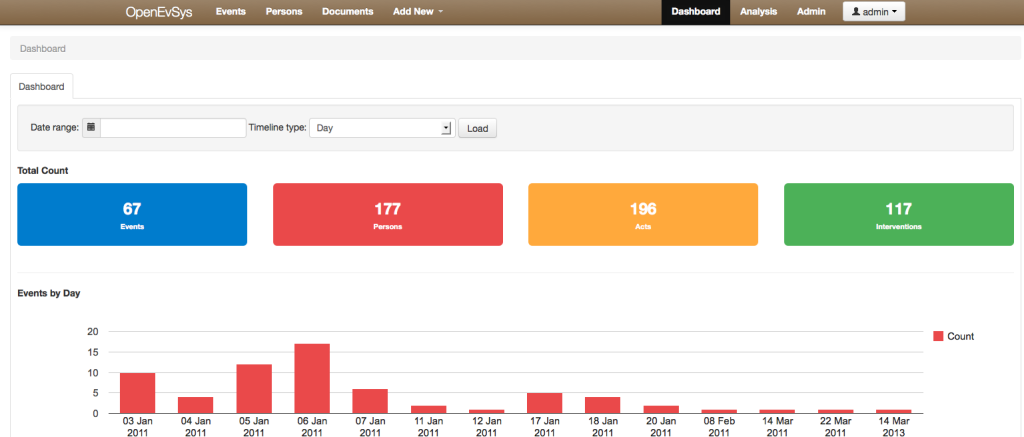With enhanced security and more powerful analysis tools OpenEvsys sees a major update. HURIDOCS’ software for documenting human rights violations will also appear in a revised look, making it easier for activists and groups to use it.
To date, OpenEvsys is already in use worldwide with larger networks, national human rights institutions, NGOs and rights groups. Their feedback guided HURIDOCS in the process of making OpenEvsys work better for them and everyone who will be using Openevsys in the future.
OpenEvsys 2.0 builds on existing strengths and adds new ones
- Even more attractive and user-friendly – now with better design based on Twitter Bootstrap, making OpenEvsys well-accessible on tablets and easier to customize according to the way you work.
- Charts, maps and a dashboard – a faceted search, integrated maps, graphs and diagrams that help you understand your data, in addition to the existing advanced search.
- More secure – we had it tested by independent security experts and improved it to protect it against SQL injection vulnerabilities.
- Field and taxonomy manager – create your own fields and taxonomies with a constructor that is web-based and is easy to use
New faceted search, great graphs, marvellous maps
What excites us most about the new OpenEvsys are newly added analytical tools that make it intuitive for users to make the most of the data they enter into the system.
Particularly noteworthy is a faceted search – one where users can click themselves through keywords to explore data and introduce filters as they go along, instead of having to build a query.
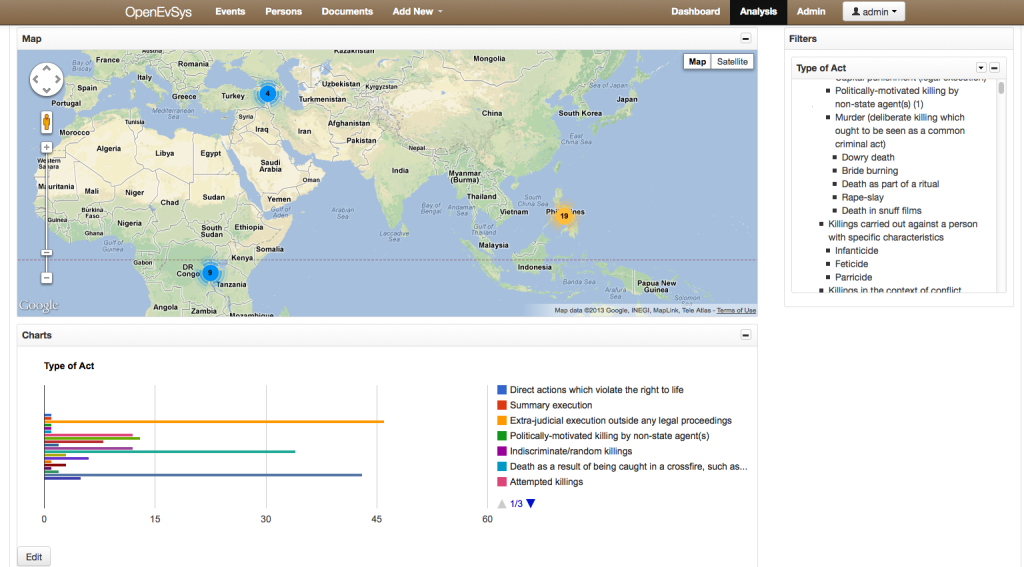
The results can be displayed in multiple ways – on maps, in graphs or diagrams. OpenEvsys will choose a good solution, but as with everything else, users can change this default, for example if you want a pie chart instead of a column chart. Thanks to this, OpenEvsys offers fast analytics that can be adjusted to give you exactly what you are looking for.

Old advanced search: don’t worry, its still there
You will still have the old Advanced Search however, we left it because many users are accustomed to it. It’s actually very powerful: not only can you generate any list you want, but you can also count what you have in that list.
So you can use the Advance Search to produce working lists, choose the columns you want in the results, and then export to Excel. Here for example is a breakdown of all acts from country=Philippines.

Here is a simple breakdown of all the acts, by type of act.
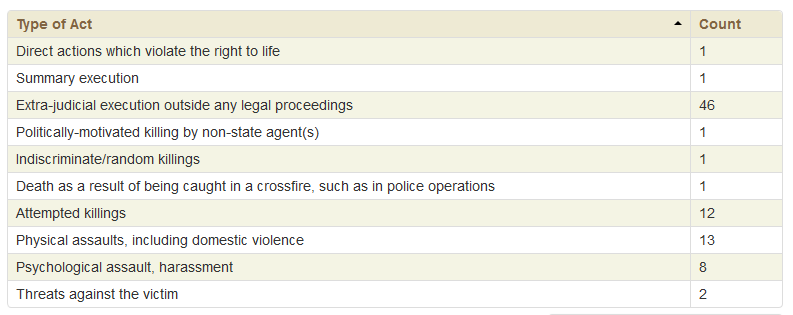
The same, but with a cross-frequency, in this case type of act by gender of victim.
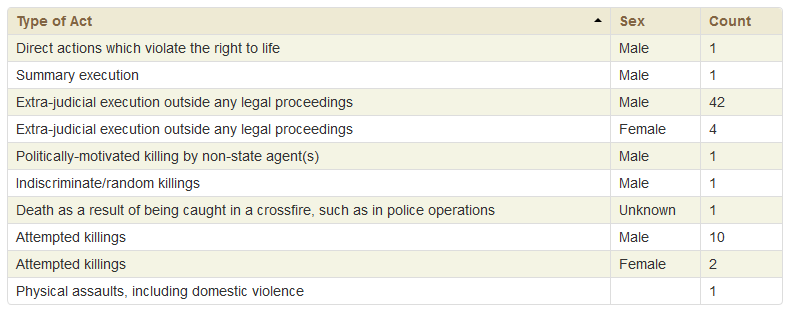
So we didn’t take away the old Advanced Search, but we made its counting feature a bit more visible, because we realized many users didn’t know it existed! How to count? Once you’ve set up your query, and clicked on the Search, then click on the Count to decide what you want to aggregate.
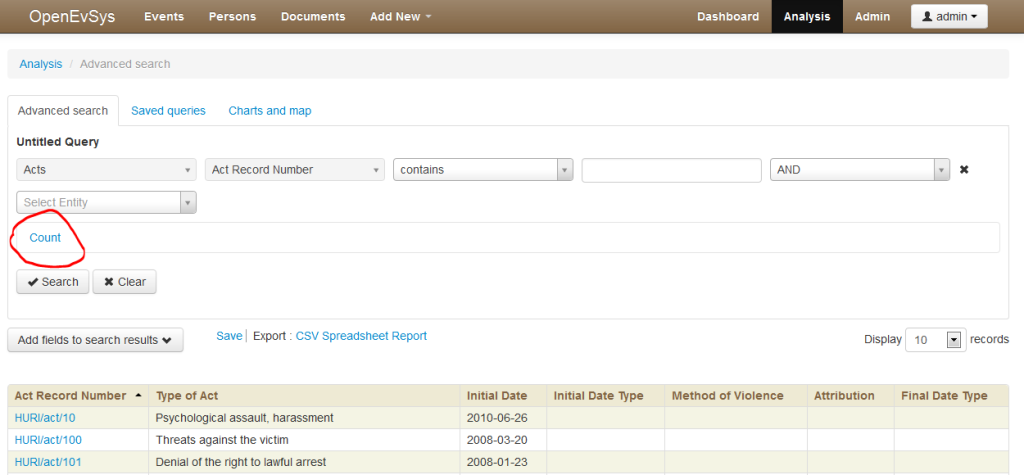
By the way, if you need help…
If you need a bit of help to use this Advanced Search, send us a mail, and we can arrange a training session by Skype. We’ll also be publishing some tutorials soon.
Geo-tagging
To enable the maps, we added added geo-tagging as a feature, meaning the precise location of an event or act can be plotted on a map, as a marker or as a polygon. This can be activated in the admin panel for all the formats in the OpenEvsys database: not only the event format, but also acts, persons, interventions can be geo-tagged.
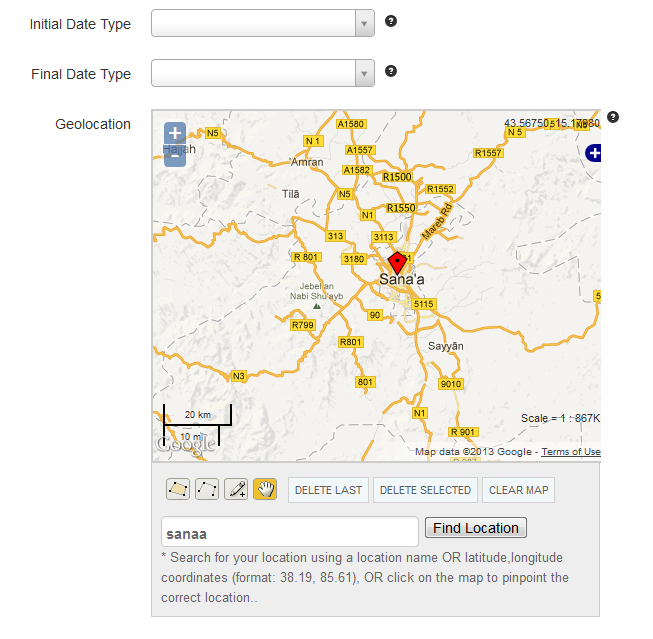
In the future, we’ll also be adding taxonomy-based mapping, using the Local Geographic Terms thesauri. This means, that you’ll be able to add the geo-codes for all your local geographic locations, and then use this taxonomy to tag your events, acts, or persons, rather than plotting them on a map. This is relevant if the precise location is not that important, meaning its enough to know that it happened in village X, you don’t need or know the exact street. This will save time, too. You can include prisons and police stations in your local geographic terms, and tag your persons by prison, to produce a map of all prisoners of conscience by prison, for example.
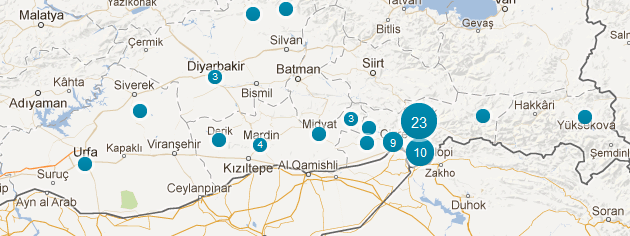
Better design for a better user experience on more devices
OpenEvsys 2.0 looks better using Twitter Bootstrap for a neat and clean design. Functionality is still the most important element of OpenEvsys, but if a better design safes you a minute or two every now and then, you surely will not object.
Twitter Boostrap is an html framework used by more and more developers to make their web applications look and behave great in the latest desktop browsers, and also in tablet and smartphone browsers via responsive CSS.
It’s not only about pretty CSS however. We also spent a lot of time polishing the interface and making it even more intuitive. So that you don’t have to ask youself “what do I do next?” when entering a case, the next steps are clearly signposted using buttons with intelligent colours and layouts that simply make sense. So if you liked OpenEvsys, you’ll love OpenEvsys 2.0!
Field and taxonomy manager
OpenEvsys was always open for customisation, although as a default it ships with fields and taxonomies based on the established Events format. In OpenEvsys 2.0 we will make it easier for you to create your own fields and taxonomies with a constructor that is web-based. It will be great to quickly make OpenEvsys work the way you already work – and get rid of those fields that may be too much for you.
Security audit to protect data
OpenEvsys is an online-based system (although you can host it locally, too), and thus more prone to attacks than data you store on a computer that has no access to the internet. Still we work hard to make OpenEvsys as secure as possible and take all concerns extremely seriously. This is why asked RedGuard, a company that specializes in information security, to audit OpenEvsys (penetration testing and partial code review).
Here is an extract from their report listing the vulnerabilities:

Following RedGuard’s recommendations, we recoded OpenEvsys to close all identified security gaps. If you want to learn more about what we did, and what the vulnerabilities were, please get in touch. We are happy to share the report with persons known to HURIDOCS and explain in more detail. To protect everyone who is using an older version, we decided to not publish this information online, however.
To enjoy the highest level of protection we recommend everyone to update to OpenEvsys 2.0 as soon as it becomes available.
Some more security-related elements:
- HURIDOCS provides OpenEvsys hosting to NGOs who do not have this technical capacity. This costs 500 USD per year and includes default SSL encryption of communications (https), installation of patches and bug fixes, and daily offline backups of the databases.
- In certain cases, we can also implement other measures such as IP-range restrictions or computer-specific authentification certificates.
- Make sure you are using a strong password, are not storing it in your browser and are not sending it around in unencrypted messages.
- OpenEvsys can also be hosted locally on a computer or server with no access to the internet (some NGOs do this). Or if used online, very sensitive information such as source names can be kept separately just to be on the safe side.
OpenEvsys 2.0 will be released in July, test it today already
OpenEvsys 2.0, will ship on 1 July. The software is ready but we still need to update the user manual and release documentation which will be published with the code.
However for those of you who can’t wait, you can try it out online here (username=admin, password=admin), or download the source code at Github. Be warned, we’re currently working on the data in the database, so when you are using the analytical features, things might not always add up. It is related to the data, not the technology, be assured. (editor’s note 10 December: the demo is no longer offered, as OpenEvsys was sunset)
Send us your feedback, if you are trying the demo, encounter an issue or have a suggestion of what should be improved. We appreciate it and will do our best to improve OpenEvsys accordingly.
HURIDOCS recommends OpenEvsys users to prepare for an update and suggest to watch this space, if you think you are a potential user.
What’s next – OpenEvsys 2.1
While we are preparing OpenEvsys 2.0 to be released 1 July, we already started thinking of what we can do afterwards. With a better design, more security and more powerful analytics we will have added many features to make OpenEvsys better software to document violations, understand the information you gather and use it for action.
We do not want to rest with this. For OpenEvsys’ future development we plan to include a fine-grained permission scheme that will allow you to define user roles and decide who can read, write, edit which parts of your documentation.
We would be interested in feedback on this idea. Also let us know of every feature that you would like to see and that would be useful for your work.
